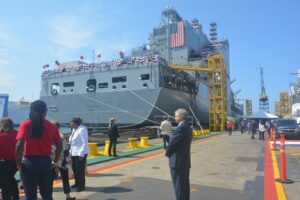The final fiscal year 2022 spending bill inserted some “Buy American” requirements in new Navy ships going forward with the next set of frigates, fleet replenishment oilers, cable laying and repair ships and oceanographic surveillance ships.
President Biden signed the Consolidated Appropriations Act, 2022
(H.R. 2471) into law on March 15 to fund the government through Sept. 30, 2022 (Defense Daily, March 15).
The law contains $782 billion for defense programs and $26.7 billion in shipbuilding, a $4.1 billion increase for five more ships than the budget request sought. It includes funding for two Arleigh Burke-class destroyers; two Virginia-class attack submarines; one Constellation-class frigate; two John Lewis-class fleet oilers; two Navajo-class towing, salvage and rescue ships; one T-AGOS(X) ocean surveillance ship; one Lewis B. Buller-class expeditionary sea base; one standard Spearhead-class Expeditionary Fast Transport ship and one configured as an expeditionary medical ship (Defense Daily, March 9).
Within the bill, it states funds for the frigate (FFG-62) and fleet oiler (T-AO-205) ships cannot be used for new contracts unless certain equipment is manufactured domestically in the U.S.
In 2020, the Navy awarded Fincantieri’s Marinette Marine a $795 million contract for the detail design and construction of the first Constellation-class frigate, with options for nine more. The Navy plans to build at least 20 frigates total, requiring a follow-on contract for additional ships.
However, the new law states starting with the 11th frigate none of the funds provided in the act for the ship class can be used to award a new contract that covers acquisition for several components unless they are manufactured within the U.S. This includes air circuit breakers; gyrocompasses; electronic navigation chart systems; steering controls; pumps; propulsion and machinery control systems; totally enclosed lifeboats; auxiliary equipment pumps; shipboard cranes; auxiliary chill water systems; and propulsion propeller.
The law said this is all provided that the Secretary of the Navy “shall incorporate United States manufactured propulsion engines and propulsion reduction gears into the [Constellation-class frigate] program beginning not later than with the eleventh ship of the program.”

Similarly, starting with the seventh and later John Lewis-class fleet oilers, funds in this law for the fleet oiler program requires several components to be manufactured domestically including auxiliary equipment (including pumps) for shipboard services; propulsion equipment (including engines, reduction gears, and propellers); shipboard cranes; spreaders for shipboard cranes; and anchor chains.
The appropriations law also has similar provisions for future Cable Laying and Repair Ships (T-ARC(X)), and Oceanographic Surveillance Ships (T-AGOS(X)).
The law language said none of the funds in the act can be used on stages of planning and contracting for the T0ARC(X) or T-AGOS(X) unless all auxiliary equipment, including pumps and propulsion shafts, are manufactured in the U.S.
This specifically covers funding for “requirements development, performance specification development, concept design and development, ship configuration development, systems engineering, naval architecture, marine engineering, operations research analysis, industry studies, preliminary design, development of the Detailed Design and Construction Request for Proposals solicitation package, or related activities.”
Separately, the appropriations law also bars any Navy funds being used to decommission the USS Fort Worth (LCS-3), Detroit (LCS-7), or Little Rock (LCS-9).
In the original FY ‘22 budget request, the Navy sought to retire four Littoral Combat Ships: LCS-3, the USS Coronado (LCS-4), LCS-7, and LCS-9 to save $186 million in an effort to divest less effective capabilities into newer capabilities (Defense Daily, May 28, 2021).
In its budget documents, the Navy argued LCS-3 and -4 are primarily test platforms and divesting avoids costs needed to upgrade them to the common configuration and adding mission packages. It argued that divesting of LCS-7 and -9 is also useful because they are experiencing the combining gear propulsion train problem and are expected to be expensive to repair (Defense Daily, July 21, 2021).
In a July 2021 Senate Appropriations defense subcommittee hearing, Vice Adm. James Kilby, then-Deputy Chief Of Naval Operations For Warfighting Requirements And Capabilities, said if the Navy is allowed to divest from them, LCS-7 and -9 might have a future as either a reserve capacity or in foreign military sales.
The Navy was previously allowed to retire the first two LCSs (LCS-1 and -2) in the final FY ‘21 budget.